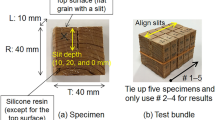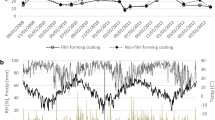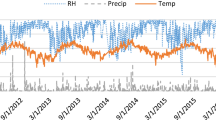Abstract
Wood decks are popular outdoor wood products in Japan, and their durability is the most important aspect for their long-term use. To prevent decay, wood members should be maintained at a low moisture condition. However, surface checks occurring during long-term use may make the moisture content inside the wood members high, causing decay. In this study, water absorption and drying tests of flat grain redwood (Sequoia sempervirens) and Japanese cedar (Cryptomeria japonica) specimens with or without a sawed slit of 10 mm or 20 mm depth were carried out. Sectional moisture content distributions of the specimens were examined in detail with an X-ray densitometry method. Consequently, the influence of slit depth of an artificial surface check on the water absorption and drying processes was revealed. Moisture content mappings at 1 mm resolution around the slit showed that the water absorption region along the tangential direction from the slit was approximately 1 mm wide after 24 h, regardless of the species and slit depth. On the other hand, high moisture content after the drying period was observed only in a specimen which had a 20 mm depth slit. For the 20-mm depth slit specimens, the moisture content at the bottom of the slit remained more than 30% after drying for 8 h, which is a moisture level sufficiently high to cause decay. The results of the tests indicate that checks that reach 20 mm in depth from the surface may increase the risk of decay.








Similar content being viewed by others
References
Bornemann T, Brischke C, Alfredsen G (2014) Decay of wooden commodities—moisture risk analysis, service life prediction and performance assessment in the field. Wood Mater Sci Eng 9:144–155
Brischke C, Melcher E (2015) Performance of wax-impregnated timber out of ground contact: results from long-term field testing. Wood Sci Technol 49:189–204
Brischke C, Meyer-Veltrup L (2015) Moisture content and decay of differently sized wooden components during 5 years of outdoor exposure. Eur J Wood Prod 73:719–728
Brischke C, Rapp AO, Bayerbach R (2008) Measurement system for long-term recording of wood moisture content with internal conductively glued electrodes. Build Environ 43:1566–1574
Brischke C, Meyer-Veltrup L, Bornemann T (2017) Moisture performance and durability of wooden facades and decking during six years of outdoor exposure. J Build Eng 13:207–215
De Groot RC (1992) Test assemblies for monitoring decay in wood exposed above ground. Int Biodeterior Biodegrad 29:151–175
Doi S, Saito M (1982) A study of growth conditions of Serpula lacrymans. Mokuzai Gakkaishi 28:733–739 (in Japanese with English abstract)
Gellerich A, Brischke C, Emmerich L, Meyer-Veltrup L, Kaudewitz P (2017) Evaluation of surface cracks on wood—physical assessment versus subjective sensation. In: IRG/WP 48th IRG Annual Meeting, Ghent, Belgium, 17-20617
Isaksson T, Thelandersson S (2013) Experimental investigation on the effect of detail design on wood moisture content in outdoor above ground applications. Build Environ 59:239–249
ISO (2007) ISO 21887 Durability of wood and wood-based products—use classes. International Organization for Standardization, Geneva
JISC (2009) JIS Z 2101 Mokuzai-no-shikenhou (methods of test for woods) (in Japanese). Japanese Industrial Standards Committee, Tokyo
Kalnins MA, Feist WC (1993) Increase in wettability of wood with weathering. For Prod J 43:55–57
Kanai T (2009) The state of exterior market and wooden exterior products (in Japanese). Mokuzaihozon (Wood Prot) 35:96–101
Li W, Van den Bulcke J, De Windt I, Van Loo D, Dierick M, Brabant L, Van Acker J (2013) Combining electrical resistance and 3-D X-ray computed tomography for moisture distribution measurements in wood products exposed in dynamic moisture conditions. Build Environ 67:250–259
Matsuo Y (1990) Shin-kentikugaku-taikei vol. 10; Kankyoubutsuri (Environmental Physics) (in Japanese), Shokokushya, Tokyo, pp 36–40
McDonald KA et al (1996) Wood decks; materials, construction, and finishing. For Prod Soc, Madison, pp 3–17
Metsä-Kortelainen S, Viitanen H (2017) Durability of thermally modified sapwood and heartwood of Scots pine and Norway spruce in the modified double layer test. Wood Mat Sci Eng 12:129–139
Meyer L, Brischke C (2015) Fungal decay at different moisture levels of selected European-grown wood species. Int Biodeterior Biodegrad 103:23–29
Mizumoto S (1964) Relation of moisture content of wood and relative humidity in an atmosphere to the decay of Japanese red pine wood, due to the attack of four species of Gloeophyllum. J Jpn For Soc 46:9–13
Niklewski J, Brischke C, Hansson EF, Meyer-Veltrup L (2018) Moisture behavior of weathered wood surfaces during cyclic wetting: measurements and modeling. Wood Sci Technol 52:1431–1450
Osawa T, Maeda K, Shida S (2018) Effect of water absorption from surface checks on the moisture retention in wood deck exposed outdoor. Mokuzaihozon (Wood Protection) 44:67–80 (in Japanese with English abstract)
Råberg U, Edlund ML, Terziev N, Land CJ (2005) Testing and evaluation of natural durability of wood in above ground conditions in European overview. J Wood Sci 51:429–440
Rapp AO, Peek RD, Sailer M (2000) Modelling the moisture induced risk of decay for treated and untreated wood above ground. Holzforschung 54:111–118
Sakai H (2009) Fungal resistance test for non-treated and treated wood in the field. J Soc Mat Sci Jpn 58:271–279 (in Japanese with English reference)
Sandberg K (2008) Degradation of Norway spruce (Picea abies) heartwood and sapwood during 5.5 years’ aboveground exposure. Wood Mater Sci Eng 3:83–93
Sandberg K, Salin JG (2012) Liquid water absorption in dried Norway spruce timber measured with CT scanning and viewed as a percolation process. Wood Sci Technol 46:207–219
Schultz TP, Nicholas DD, Ingram LL Jr (2007) Laboratory and outdoor water repellency and dimensional stability of southern pine sapwood treated with a waterborne water repellent made from resin acids. Holzforschung 61:317–322
Siau JF (1971) Flow in wood. Syracuse University Press, New York, pp 15–34
Stirling R, Morris PI (2015) Factors affecting performance of preserved wood decking against decay fungi. In: IRG/WP 46th IRG Annual meeting, Viña del Mar, Chile, 15-30663
Suzuki K (1986) Moisture content levels and decay of hemlock. In: IRG/WP 17th IRG Annual meeting, Avignon, France, 1287
Suzuki K (2002) Mokuzoujyuutakuno-taikyuusekkeito-ijikanri-rekkashindan (durability design, maintenance, and inspection for wooden houses). Japan Housing and Wood Technology Center, Tokyo, pp 146–147 (in Japanese)
Tanaka T, Avramidis S, Shida S (2009) Evaluation of moisture content distribution in wood by soft X-ray imaging. J Wood Sci 55:69–73
Van den Bulcke J, Van Acker J, De Smet J (2009) An experimental set-up for real-time continuous moisture measurements of plywood exposed to outdoor climate. Build Environ 44:2368–2377
Viitanen HA (1997) Modelling the time factor in the development of brown rot decay in Pine and Spruce sapwood—the effect of critical humidity and temperature conditions. Holzforschung 51:99–106
Watanabe K, Saito Y, Avramidis S, Shida S (2008) Non-destructive measurement of moisture distribution in wood during drying using digital X-ray microscopy. Dry Technol 26:590–595
Watanabe K, Lazarescu C, Shida S, Avramidis S (2012) A novel method of measuring moisture content distribution in timber during drying using CT scanning and image processing techniques. Dry Technol 30:256–262
Author information
Authors and Affiliations
Corresponding author
Additional information
Publisher’s Note
Springer Nature remains neutral with regard to jurisdictional claims in published maps and institutional affiliations.
Rights and permissions
About this article
Cite this article
Osawa, T., Maeda, K., Tsunetsugu, Y. et al. Influence of surface checks on wood moisture content during wetting and re-drying. Eur. J. Wood Prod. 77, 681–689 (2019). https://doi.org/10.1007/s00107-019-01423-w
Received:
Published:
Issue Date:
DOI: https://doi.org/10.1007/s00107-019-01423-w




